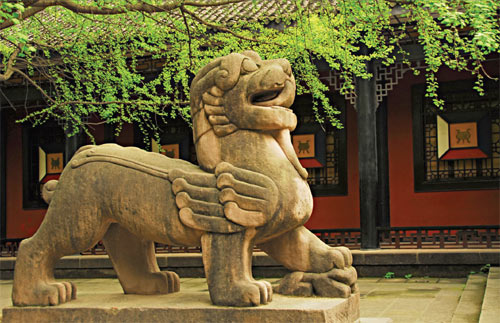
Both good and evil beasts abound in ancient chinese mythology, and are deeply rooted in the country's cultural traditions
Each time Zhong Xiaowen goes out to play her regular game of mahjong, she carries with her a jade pixiu. The pixiu is a creature from Chinese mythology, resembling a winged lion with white and gray fur that is said to protect its master from evil and bring him wealth. Alongside the dragon, phoenix, tortoise and qilin (a cross between a lion and a dragon) it ranks among the most auspicious creatures according to Chinese legend.
 |
|
The stone pixiu stands outside the Temple of Marquis in Chengdu. People believe the creature can bring wealth. PROVIDED TO CHINA DAILY |
Carrying a miniature pixiu is a common practice in the south of China. It is believed to be the ninth son of the Dragon King and to eat only gold and silver. Legend has it that one day the Jade Emperor, the governor of heaven, slapped it on its hip for making a mess on the carpet, sealing its anus so that any gold and silver it ate remained inside. The Chinese interpreted this tale as meaning it would bring wealth and stop it from flowing away.
"Unlike Greek mythology, Chinese mythology is rather scattered and fragmented in different books in different dynasties," says Guo Minde, a researcher at Beijing Folklore Society.
"Even the creators of humankind, Nuwa and Fuxi, are referred to in a vague manner with one version of them having a human head wrapped in a snake's body."
In other versions they appear as a man and woman or gods.
"Often the creatures in one system of mythology show up in another, so we have hundreds of creatures, not including humanoid beasts," Guo says.
A number of beasts from Chinese mythology are linked to astrology. The ancient Chinese divided the sky into three inner areas centered on the north star. Beyond these were a further four sections of sky governed by an azure dragon in the east, a white tiger in the west, a rose finch in the south and xuanwu, a hybrid of a tortoise and a snake, in the north.
"In many ways, these four star symbols represented a mirror of the earth in the sky and they still exert great influence in the daily life of East Asian people," Guo says.
Earthly symbols of these beliefs continue to stand across Asia. The southern gate of Xi'an's old city wall is called Rose Finch Gate. Before the entrance of Kiyomizu Temple in Kyoto, Japan, stands a statue of an azure dragon.
Xuanwu is usually depicted as a black tortoise, but also sometimes as a snake coiling around a tortoise. It rose to prominence in mythological tales during the Song Dynasty (960-1279). Legend has it the Jade Emperor reincarnated one of his three souls into the world, but the soul was uninterested in power and instead began to study Taoism from the age of 16, eventually achieving divine status and becoming xuanwu, a deity of the northern sky.
 |
|
In Chinese mythology Nuwa (left) and Fuxi are the creators of humankind. PROVIDED TO CHINA DAILY |
Most Chinese mythological creatures are included in the book Shanhaijing, which means "classic of the mountains and seas", a compilation of early geography and myth that describes more than 400 gods and mythical creatures.
One chapter describes an animal called a qiuyu as having round eyes, a thin tail, a long beak and a body like a rabbit. When it comes across a human it coils its body into a ball to protect itself.
"The description is quite similar to an armadillo now living in America. Perhaps in ancient times they lived in Asia. One cannot be sure whether or not those recordings in the book are a real recollection of the pre-historic world or not," Guo says.
"These myths and legends were either passed down orally or written down and are linked with the founding of Chinese culture. Personally I think at least in part they are a factual recording of the past we barely know."
Among the hundreds of creatures, the Chinese dragon is perhaps the most important in Chinese mythology. These divine beasts were said to govern all the waters on earth, and came in many variations. Tianlong, the heavenly dragon, guarded the celestial palaces and pulled chariots in heaven. Fucanglong, the hidden treasure dragon, guarded the underworld's precious metals and jewels hidden inside volcanoes. Shenlong, the god dragon, controlled thunder. Dilong, the earth dragon, governed the rivers and the seas. Yinglong, a winged dragon, was associated with rains and floods. In the mythological tale Three Sovereigns and Five Emperors, Yinglong helped the Yellow Emperor defeat his enemy Chiyou.
Huanglong was a hornless dragon that appeared later than most others and was deemed to be the reincarnation of the emperor. Its strong monarchist connotations meant it became the national emblem of the Chinese people.
While dragons are portrayed as good and protectors in Chinese mythology, there are also evil creatures. The four main evil beasts are taotie, which represents the sin of gluttony; hundun, a legendary faceless being that represents chaos; taowu, a monster that brings with it confusion and apathy; and qiongqi, which represents deviousness.
"One reason why the Chinese have so many creatures is perhaps because original Chinese mythology had an extensive interaction with the later belief systems that are still prevalent today, such as Confucianism, Taoism, and Buddhism," Guo says.
"With the passage of time, new elements were assimilated into Chinese culture, so that creatures from new belief systems have also been incorporated into Chinese mythology."
zhanglei@chinadaily.com.cn
